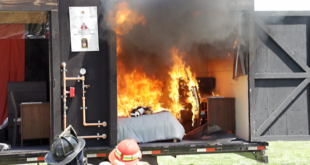For the last several months we have been exposing readers to the concept of fire testing and the use of standards. This month we are going to see if you picked up any of the vocabulary of these methods. The following are a few definitions that should be part of your lexicon. Take a few minutes and fill in the blanks and see how well you do on the language of fire testing.
- A __________ is a means of deter- mining whether fire protection products meet minimum performance criteria as set out in a building code or other applicable legislation.
- The ability to be worn away or eroded in thickness because of heat or some other abrasive is called __________.
- A term used to refer to a material or assembly that has been tested to meet specific test criteria (or standard) by an independent, recognized laboratory is called __________.
- The organization that issues the “Certificate of Occupancy Permit” in a municipality is called the _________.
- A fire-resistance rated wall, having protected openings, which restricts the spread of fire and extends continuously from the foundation to or through the roof is called a __________.
- The type of construction that does not meet the requirement for noncombustible construction is called __________.
- A material, device or construction installed to restrict the movement of air within open spaces of concealed areas of building components such as crawl spaces, floor-ceiling assemblies, roof-ceiling assemblies and attics is called a __________.
- A characteristic of a material that is flexible and permits movement is called __________.
- A characteristic of a material that blocks heat by chemical absorption and moisture release for fire resistance is called __________.
- A characteristic of a material that produces heat by chemical reaction is called __________.
- The aggregate floor area enclosed and bounded by building separation walls, fire barrier walls, exterior walls or fire-resistance rated horizontal assemblies of a building is called the __________.
- Building material that is installed to resist the free passage of flame and gasses to other areas of the building through small concealed spaces is called __________.
- A fire-resistance rated assembly of materials having protected openings which is designed to restrict the spread of fire is called a __________.
- An enclosed space in a building that is separated from all other parts of the building by enclosing construction, providing a fire separation having a required fire-resistance rating, is sometimes called a __________.
- A device, installed in an air distribution system, designed to close automatically upon detection of heat, to interrupt migratory airflow, and to restrict the passage of flame is called a __________.
- Any combination of a fire door, frame, hardware, and other accessories that together provide a specific degree of fire protection to the opening is called a __________.
- A vertical assembly of materials having protected openings and designed to restrict the spread of fire is called a __________.
- That property of materials or their assemblies which prevents or retards the passage of excessive heat, hot gases or flames under conditions of use is called __________.
- A construction assembly that acts as a barrier against the spread of fire is called __________.
- The distance in feet measured from the building face to the closest interior lot line, to the centerline of a street, alley or public way, or to an imaginary line between two buildings on the property is called __________.
- A type of fire separation of noncombustible construction which subdivides a building or separates adjoining buildings to resist the spread of fire and which has a fire-resistance rating as prescribed in the codes and has structural ability to remain intact under fire condition for the required fire-rated time is called a __________.
- The characteristic of certain fire barrier products that, when exposed to heat, expands to fill a void in the penetration caused by the deformation or combustion of the through penetrating item is called __________.
- That type of construction in which a degree of fire safety is attained by the use of noncombustible materials for structural members and other building assemblies is called __________.
- An opening created in a membrane or assembly to accommodate penetrating items for electrical, mechanical, environmental, and communication systems is called a __________.
- As applied to a fire door or other opening, __________ means that it is equipped with an approved device that will ensure closing after having been opened.
- Any enclosed space extending through one or more stories of a building, connecting vertical openings in successive floors, or floors and roof is called a __________.
- An assembly of walls, partitions, floors and openings therein as will prevent the transmission of smoke or gases through the construction is called a __________.
- The space within a building enclosed by smoke barriers on all sides, top and bottom is called a __________.
- Accredited Standards Council testing agencies approved to perform fire endurance testing as identified by National and International Accreditation Testing Systems is often called a __________.
- An opening that passes through the entire separating assembly is called a __________.
Expert Question 1. The fire test method, labeled “Fire Tests of Building Construction and Materials,” conducted to evaluate the ability of a fire-resistive floor or wall assembly to perform its barrier function, resisting the passage of heat, flames, hot gases, and smoke in a fire situation is called __________.
Expert Question 2. The test entitled “Surface Burning Characteristics of Building Materials” usually refers to the flame spread or smoke developed characteristics of a product (i.e., wallpaper, coatings, carpet, etc.) is called ____________.
How did you do? Scroll down for quiz answers.
 ABOUT THE AUTHOR: Ronny J. Coleman is currently the president of Fireforceone. He is a past president of the IAFC and CFAI. Over his lifetime, he has received numerous awards including the AFSA’s 1989 Henry S. Parmelee Award, the 2011 Mason Lankford Award from the Congressional Fire Services Institute, and the Tom Brennan Lifetime Achievement Award from Fire Engineering in 2014. He continues as a contributor to the fire service in many ways.
ABOUT THE AUTHOR: Ronny J. Coleman is currently the president of Fireforceone. He is a past president of the IAFC and CFAI. Over his lifetime, he has received numerous awards including the AFSA’s 1989 Henry S. Parmelee Award, the 2011 Mason Lankford Award from the Congressional Fire Services Institute, and the Tom Brennan Lifetime Achievement Award from Fire Engineering in 2014. He continues as a contributor to the fire service in many ways.
EDITOR’S NOTE: This article concludes this six-part series. Part 1 appeared in the April 2015 issue; Part 2 in the June 2015 issue; Part 3 in the August 2015 issue; Part 4 in the September 2015 issue; and Part 5 in the November 2015 issue.
Following are the answers to the AHJ Perspective “Ratings, Fire Testing and Standards” quiz.
1. Fire Test
2. Ablative
3. Approved
4. Authority Having Jurisdiction
5. Building Separation Wall
6. Combustible Construction
7. Draft Stop
8. Elastomeric
9. Endothermic
10. Exothermic
11. Fire area
12. Fireblocking
13. Fire Barrier Wall
14. Fire Compartment
15. Fire Damper
16. Fire Door Assembly
17. Fire Partition
18. Fire Resistance
19. Fire Separation
20. Fire Separation Distance
21. Fire Wall
22. Intumescent
23. Non-Combustible
24. Penetration
25. Self Closing
26. Shaft
27. Smoke Barrier
28. Smoke Compartment
29. Third Party Testing Agency
30. Through Penetration
Expert Questions
1. ASTM 119
2. ASTM E 84
 Sprinkler Age A Publication of the American Fire Sprinkler Association
Sprinkler Age A Publication of the American Fire Sprinkler Association

